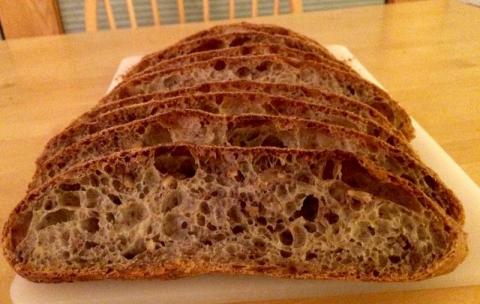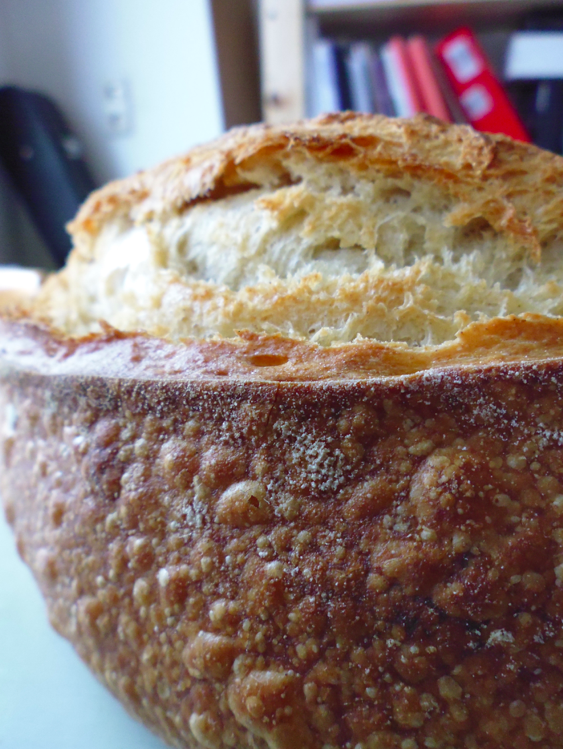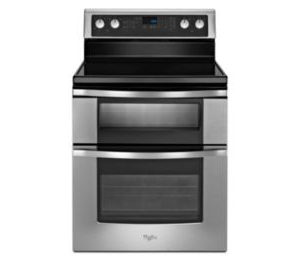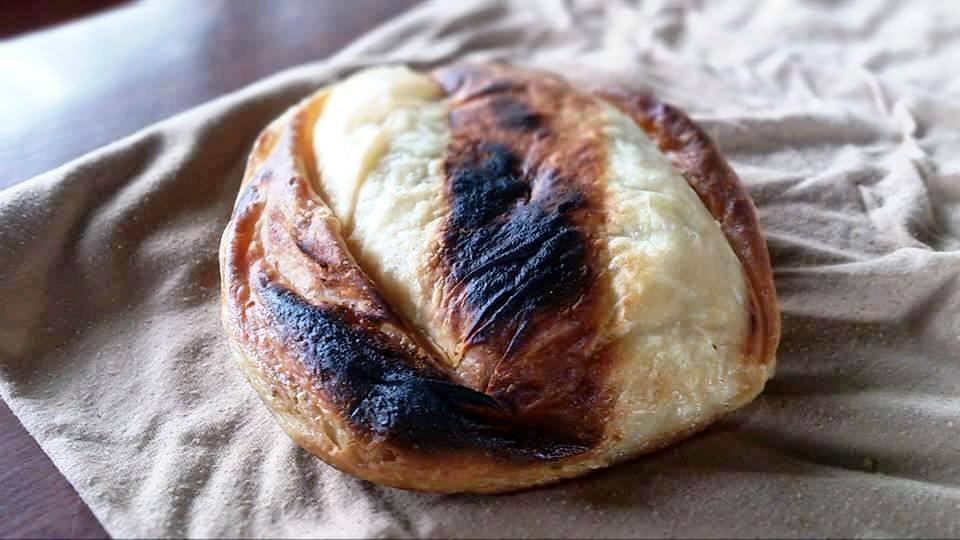It is supposed to rain for the net two days here in the AZ desert but be clear for the Super Bowl on Sunday. No worries anyway since the stadium has a real grass movable field and a movable roof too. Still, Lucy was thinking about how beautiful, if dry and desolate, the desert usually is while I was thinking about how much the desert and Lucy’s brain are alike. It’s odd how the names of her breads come about.

This one was a mix of 5 sprouted and whole grains including, wheat, spelt, rye, einkorn and emmer (Hayden Mills Farro) The whole and sprouted grains totaled 40% of the flour and half of them were sprouted. The levain was 13% of the flour and the hydration was 77% so, it was not too wet for a change.


With sprouted grains in the mix, we start on Tuesday for a Friday’s weekly bake. First the grains have to be soaked for 3-4 hours and sprouted up to the 24 hour mark or so – stopping them when they first begin to ‘chit’ showing their first tiny toots Then o Wednesday we dry them in the dehydrator at 105 F and then grind them with the other whole grains.

Then the milled whole grain sprouted flours are sifted to remove hard bits (in this case 28% extraction) that we feed to the starter in 3 stages (2 -3 and 4 hours in this case) to make the levain. This left the 72% extraction for the dough flour mix. Once the levain doubles after the 3rd feeding it goes into the fridge of a 24 hour cold retard at 36 F.

On Thursday we got out the levain from the fridge and the yogurt whey from the freezer. We zapped the whey in the microwave to thaw it out and warm it up for the autolyse which was an hour as the levain warmed up. We sprinkled the salt on the top of the autolyse so we wouldn’t forget it.

Once the levain hit the mix, we mixed it in a bit with a spoon before beginning the 3 sets of slap and folds on 8, 1 and 1minute and 3 sets of stretch and folds from the compass points . All were done 20 minutes apart, and the dough stopped sticking to the counter at the end of first set of slap and folds.

A yummy cheesecake and a deep dish chicken pot pie!

We then let the dough ferment and rest for a half and hour before putting it in a plastic oiled bowl for a 8 hour bulk ferment, followed by a shaped 12 hour cold proof making this bake a quadruple retard - a week for the starter, 24 hours for the levain and 8 hour bulk ferment and a 12 hour proof.

How Lucy comes up with these methods just goes to show how much she has slowed down. It has been forever since we tried to do this quadruple madness and the last time wasn’t pretty if I remember right - which proves beyond a doubt how much I have slowed down too.

Thank goodness geneticists have isolated a jellyfish gene that makes people not be so forgetful – great for Alzheimer’s cases. You can now be genetically modified to perk up the old brain pan in ways like never before. I’m trying to get them to put it in wheat so I can kill two birds with one stone!

Once the dough came out of the fridge after the 12 proof, we let it warm up on the counter heating pad for 1 ½ hours before starting up Big old Bets to 500 F preheat. We un- molded the dough onto parchment paper on a peel, gave it one big slash, onto the bottom stone it went and quickly covered by our heavy aluminum MagnaLite turkey roaster bottom for 20 minutes of steam . After 2 minutes we turned the oven down to 450 F

Once the lid came off, we continued baking at 425 F convection for 20 minutes until the temperature read 205 F. Once the oven was off, we left the bread on the stone for another 5 minutes until it hit 208 F and then removed it to a cooling rack. The dough sprang and bloomed pretty good under steam and browned up well enough too. It was a bit over proofed but not horribly so.

Can’t wait to see the crumb once it cools down. The crumb came out not as open as the rise and spring would suggest. Still, it was very soft moist and glossy. A perfect sandwich crumb. This is the kind of crumb we get when we do a long bulk ferment in the fridge and then a long shaped proof in the fridge too -just too much messing with the dough. Once the again, the taste was great and quite different than the porter bread. The whey added a sharper tang but not too much. The sprouts really came through too. A fine loaf that we can't wait to make toast out of tomorrow for breakfast and a sandwich for lunch.

Taco Tuesdays are always a hit as was the sandwich for lunch.

SD Levain Build | Build 1 | Build 2 | Build 3 | Total | % |
1 Week Retarded Rye Sour Starter | 10 | 0 | 0 | 10 | 1.53% |
28% Extract Sprouted & Whole 5 Grain | 10 | 20 | 43 | 73 | 11.18% |
Water | 10 | 20 | 43 | 73 | 11.18% |
Total | 30 | 40 | 86 | 156 | 23.89% |
| | | | | |
Levain Totals | | % | | | |
Flour | 78 | 11.94% | | | |
Water | 78 | 11.94% | | | |
Levain Hydration | 100.00% | | | | |
Levain % of Total Flour | 11.94% | | | | |
| | | | | |
Dough Flour | | % | | | |
72% Extraction Sprouted and Whole 5 Grain | 185 | 28.33% | | | |
KA Bread & LaFama AP 50/50 | 390 | 59.72% | | | |
Total Dough Flour | 575 | 88.06% | | | |
| | | | | |
Salt | 13 | 1.99% | | | |
Yogurt Whey | 425 | 65.08% | | | |
| | | | | |
Dough Hydration | 73.91% | | | | |
Total Flour w/ Starter | 653 | | | | |
Yogurt Whey & Water | 503 | | | | |
| | | | | |
Total Hydration w/ Starter & Adds | 77.03% | | | | |
Total Weight | 1,169 | | | | |
% Whole & Sprouted Grains - half each | 40.28% | | | | |

Lucy reminds us to never ever forget to add a good salad to any meal.

























